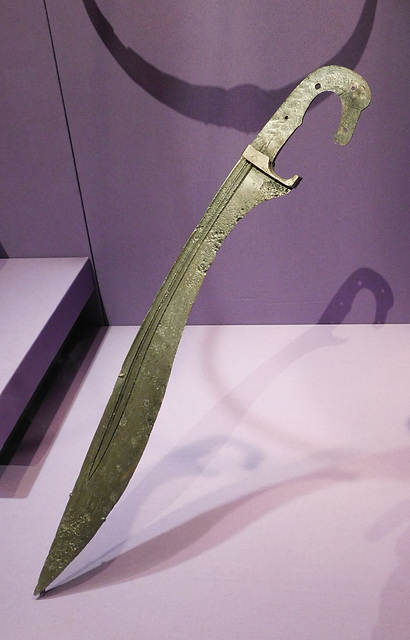Falcata Type Sword in the Metropolitan Museum of A…
Fayum Portrait of a Young Woman in Red in the Metr…
Fayum Portrait of a Young Woman in Red in the Metr…
Reliquary Monstrance of St. John the Baptist in th…
Reliquary Monstrance of St. John the Baptist in th…
Jester Candle-holder in the Metropolitan Museum of…
Detail of a Jester Candle-holder in the Metropolit…
Latin Bible with Leather Binding in the Metropolit…
Veranda Post with an Equestrian Figure and Female…
Veranda Post with an Equestrian Figure and Female…
Detail of the Veranda Post with an Equestrian Figu…
Detail of the Veranda Post with an Equestrian Figu…
Human-Headed Winged Genie Relief in the Metropolit…
Human-Headed Winged Genie Relief in the Metropolit…
Marble Inscribed Cippus in the Metropolitan Museum…
Marble Inscribed Cippus in the Metropolitan Museum…
Julio-Claudian Funerary Altar in the Metropolitan…
Julio-Claudian Funerary Altar in the Metropolitan…
Detail of a Julio-Claudian Funerary Altar in the M…
Square with a Bucolic Landscape in the Metropolita…
Tapestry Fragment with Two Figures in the Metropol…
Glass Cage Cup Vivas Diatretum in the Metropolitan…
Glass Cage Cup Vivas Diatretum in the Metropolitan…
Detail of the Fresco of the Banquet Scene from the…
Detail of the Fresco of the Banquet Scene from the…
Detail of the Fresco of the Banquet Scene from the…
Detail of the Fresco of the Banquet Scene from the…
Detail of the Fresco of the Banquet Scene from the…
Detail of the Fresco of the Banquet Scene from the…
Detail of the Fresco of the Banquet Scene from the…
Detail of the Fresco of the Banquet Scene from the…
Detail of the Fresco of the Banquet Scene from the…
Detail of the Fresco of the Banquet Scene from the…
Detail of the Fresco of the Banquet Scene from the…
Detail of the Fresco of the Banquet Scene from the…
Detail of the Fresco of the Banquet Scene from the…
Detail of the Fresco of the Banquet Scene from the…
Detail of the Fresco of the Banquet Scene from the…
Detail of the Fresco of the Banquet Scene from the…
Detail of the Fresco of the Banquet Scene from the…
Detail of the Fresco of the Banquet Scene from the…
Detail of the Fresco of the Banquet Scene from the…
Detail of the Fresco of the Banquet Scene from the…
Detail of the Fresco of the Banquet Scene from the…
Detail of the Fresco of the Banquet Scene from the…
See also...
Keywords
Authorizations, license
-
Visible by: Everyone -
All rights reserved
-
143 visits
Falcata Type Sword in the Metropolitan Museum of Art, March 2022


Title: Sword (Falcata)
Date: 5th–1st century BCE
Culture: Iberian
Medium: Iron alloy
Dimensions: H. 20 15/16 in. (53.2 cm); H. of blade 17 in. (43.2 cm); W. 2 5/8 in. (6.7 cm); D. 13/16 in. (2.1 cm); Wt. 1 lb. 0.7 oz. (473.4 g)
Classification: Swords
Credit Line: The Collection of Giovanni P. Morosini, presented by his daughter Giulia, 1932
Accession Number: 32.75.260
The falcata was a popular type of sword in the Iberian Peninsula from the fifth to the first century B.C. Closely related in form to slashing weapons found in Greece, it is distinguished by the fact that its blade is double-edged for about half of its length, whereas Greek specimens normally have a single cutting edge.
Although its old patina was removed and an inaccurate modern wood grip was added sometime before it was acquired, The Metropolitan Museum's falcata occupies an important place among the examples known to survive because of the otherwise fine state of preservation of its blade, which is structurally intact and only superficially corroded.
Text from: www.metmuseum.org/art/collection/search/32256
Date: 5th–1st century BCE
Culture: Iberian
Medium: Iron alloy
Dimensions: H. 20 15/16 in. (53.2 cm); H. of blade 17 in. (43.2 cm); W. 2 5/8 in. (6.7 cm); D. 13/16 in. (2.1 cm); Wt. 1 lb. 0.7 oz. (473.4 g)
Classification: Swords
Credit Line: The Collection of Giovanni P. Morosini, presented by his daughter Giulia, 1932
Accession Number: 32.75.260
The falcata was a popular type of sword in the Iberian Peninsula from the fifth to the first century B.C. Closely related in form to slashing weapons found in Greece, it is distinguished by the fact that its blade is double-edged for about half of its length, whereas Greek specimens normally have a single cutting edge.
Although its old patina was removed and an inaccurate modern wood grip was added sometime before it was acquired, The Metropolitan Museum's falcata occupies an important place among the examples known to survive because of the otherwise fine state of preservation of its blade, which is structurally intact and only superficially corroded.
Text from: www.metmuseum.org/art/collection/search/32256
- Keyboard shortcuts:
Jump to top
RSS feed- Latest comments - Subscribe to the comment feeds of this photo
- ipernity © 2007-2025
- Help & Contact
|
Club news
|
About ipernity
|
History |
ipernity Club & Prices |
Guide of good conduct
Donate | Group guidelines | Privacy policy | Terms of use | Statutes | In memoria -
Facebook
Twitter

Sign-in to write a comment.